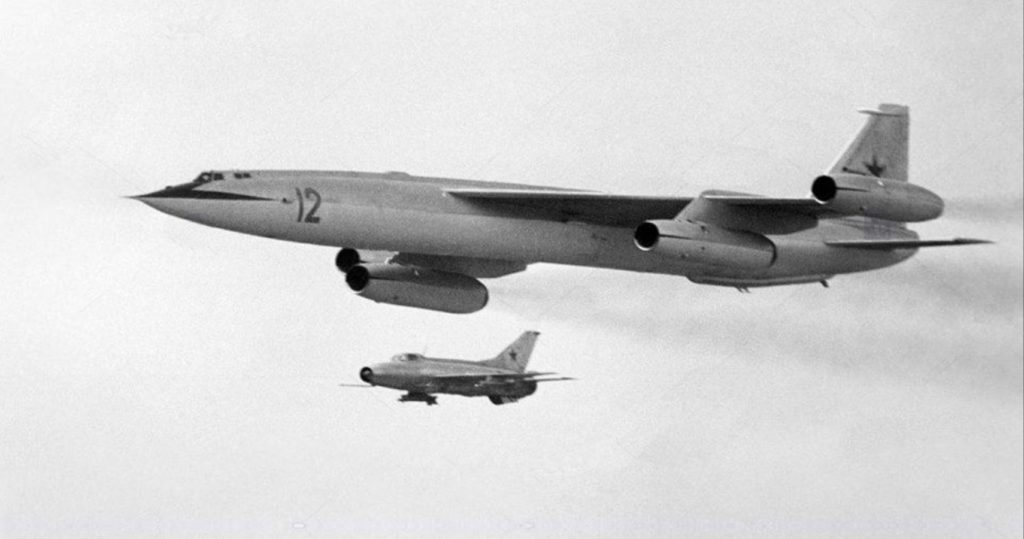[ad_1]
The Cold War was one of the most fascinating and interesting periods in the history of military aircraft. The West and the Soviet Union were constantly trying to find out who was doing what, and try to get one up over the other when the other side brought out a new aircraft. Naturally, not every machine developed would work out well. There were plenty of missteps along the way, and there were a lot of those in the Soviet Union.
We of course had aircraft like the Tu-144 “Konkordski” airliner, the crude copy of Concorde. There was the Yak-38, a VTOL aircraft similar to the Harrier, but nowhere near as successful. Then there was the Myasishchev M-50 Bounder, one of the most bizarre and intriguing aircraft the Soviet Union ever made. When the West first laid eyes upon it, they were simply astounded by what the Myasishchev company had produced, and naturally wanted all the details. But, those details did not come forwards. The M-50 turned out to be another great white elephant for Russia and one that also lead to a nuclear-powered bomber hoax.
The Soviet Union’s First Supersonic Bomber
The Bounder was set to become the Soviet Union’s first supersonic bomber. The Soviet Union needed an aircraft that could fly faster and carry heavier payloads than the Boeing B-52, and also the upcoming next generation strategic bomber that the United States was developing. That of course led to the failed XB-70 Valkyrie. So the Myasishchev company was thus tasked with creating a new aircraft, powered by two Dobrynin VD-7 non-afterburning turbojets and two VD-7F afterburning jets, and it would have a large delta wing, slender fuselage and swept back tail design. The engines were unusually mounted in pods inboard and on the wingtips. This led to an incredibly unusual design. And one of the most striking of the entire Cold War period.
The aircraft first took flight in October 1959, but a year before that in December 1958, the aircraft was the subject of a hoax. An issue of the Aviation Week magazine included an article called “Soviets Flight Testing Nuclear Bomber” and it claimed the Soviet Union had indeed made great progress with a nuclear bomber, that it could fly for days on end and with a sketch of what was actually the M-50. The reality was though that this was nothing more than a hoax, and when the M-50 was first seen it was clear it wasn’t a nuclear bomber.
A Bomber That Confused The West
The M-50 made its first appearance to the public at the Soviet Aviation Day flyby in 1961, and was also seen by the West. And while it initially looked intimidating and striking, the West were quite puzzled. Aerodynamically, the aircraft looked like a bit of a mismatch. The huge engines had no inlet centerbodies, required for supersonic flight. Plus, its shape looked to ignore basic aerodynamic principles, such as the straight edge of the wing, engine location and no narrowing of the fuselage.
Western intelligence concluded that the aircraft would have suffered a lot of drag at transonic and subsonic speeds. This then led to the NATO reporting name of Bounder, which meant “a person trying to present themselves as someone above their station”. Despite this, the West still had no real idea what the aircraft was capable of. There was every chance that the M-50 could indeed be capable of supersonic flight. But the reality was that things were not good within the project, and this Soviet Aviation Day flyby was the first and last time the West laid eyes on the jet.
Myasishchev’s Troubled And Failed Project
For starters, the engines on the M-50 were not powerful enough. These were basically the same engines from the aircraft’s predecessor, the Myasishchev M-4, with two of them now with afterburners. The aircraft was initially supposed to have Zubets 16-17 turbofans, which an under construction development, the M-52, was due to have. But while the engines were an issue, there was a bigger one. No matter what the Soviet Union tried, the M-50 stubbornly would not go supersonic. It couldn’t even break Mach 1, let alone the Mach 2 that they had aimed for. And after just 11 flights, the M-50 project was subsequently abandoned. The aircraft would complete just 19 flights in total. It’s final flight was on July 9th 1961, with a flypast at the annual Tushino Air Show.
The M-50 Proved That Looks Can Be Deceiving
While the M-52 was in fact completed, it too was then cancelled as the Soviet Union abandoned the entire supersonic bomber project. The M-50 had also proven to be a real handful to fly, and it took a lot of skill from its two pilots to fly the aircraft. The Soviet Union soon switched focus to intercontinental ballistic missiles, and focussed on upgrading its fleet of Tupolev Tu-95 Bear turboprop bombers. The M-50 was certainly a dramatic looking aircraft, but it was an even more dramatic failure. And it meant the West could breathe easy, knowing they had the advantage when it came to long range bombers. Remarkably, the one M-50 that Myasishchev built is still with us, on display at the Monino Museum outside Moscow.
Sources: Old Machine Press, YouTube, Global Security
[ad_2]
Source link






